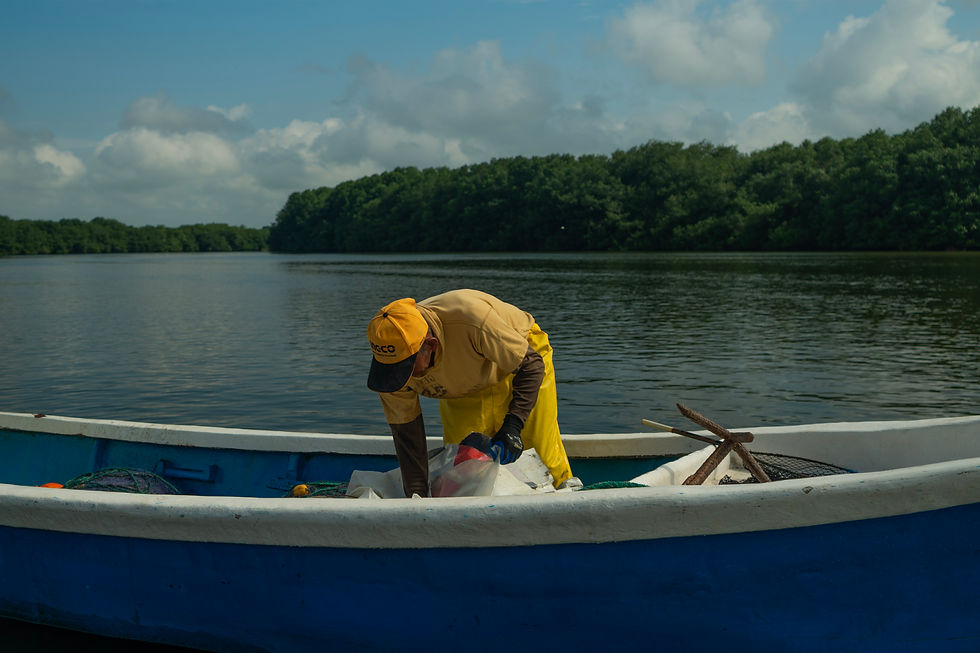Puerto El Morro: The Community that Guards the Mangrove
- The Nature Conservancy
- Jul 28
- 3 min read
Updated: Aug 1
Carolina Bustamante, The Nature Conservancy
Don Adolfo Ávila has spent half a century working in the mangrove. His work as a shellfish and crab gatherer begins early in the morning when the tide is low. Alongside his fellow members of the Manglares Porteños Artisanal Fishers Cooperative, he sets out for the day’s work. They are all natives of Puerto El Morro, located in El Morro parish, Guayas province, about two and a half hours from Guayaquil, Ecuador’s largest city.
“My father used to say, ‘We have to go fishing,’ and that was it—I’d go. The mangrove gave us our income and food for the family,” says Don Adolfo as he digs through the mud with his tool to collect shells.
This work, which has long been the economic backbone of Puerto El Morro, has declined over the years due to various factors such as pollution and mangrove deforestation. Younger generations are seeking opportunities in the cities or, in the best cases, pursuing higher education. However, for those who continue the daily task of gathering crustaceans, the mangroves are more than just a source of income and food—they’ve become part of the family.
Mangroves are highly efficient at capturing and storing carbon, helping to mitigate climate change. Their carbon storage capacity is significantly greater than that of other forest types. They also protect coastal communities from strong waves and winds. In this context, The Nature Conservancy (TNC) works with several coastal communities in Ecuador, providing training on monitoring and surveillance, mangrove conservation, proper shellfish and crab harvesting, community governance, and promoting sustainable livelihoods—such as in the case of Puerto El Morro.
Geovanny Zambrano, Coastal Marine Technical Specialist, explains that TNC is working with several coastal communities in Guayas to establish two new Sustainable Use and Mangrove Ecosystem Stewardship Agreement Areas (AUSCEMs), locally known as mangrove concessions. These are legal instruments that allow community management of mangrove areas in Ecuador for a period of 10 years. These agreements are formal contracts between the state and organized user groups—such as ancestral communities, associations, and cooperatives—allowing them to sustainably use and steward mangrove areas recognized as public goods.
That’s why, when Don Adolfo collects shells and crabs, he does so with the speed and precision necessary to respect the conservation of the ecosystem. In the case of crabs, he explains that traps should be avoided. Proper harvesting ensures that only mature male individuals of adequate size are captured, allowing populations to reproduce and maintain their numbers. Traps can catch immature individuals, affecting the population’s ability to regenerate. Manual collection allows gatherers to carefully select individuals, reducing incidental catch, which already impacts their daily work.
“Before, we spent less time collecting and didn’t have to dig so deep into the mud. Now we spend over four hours to get about 28 crabs, 30 at most per day,” says Don Adolfo.

Alongside crustacean harvesting is the management of the mangrove nursery. Those who work there carry out each task with the awareness that mangroves help improve water quality by filtering pollutants and sediments. This benefits not only marine ecosystems but also the human communities that depend on these waters. Diana Marcial is part of a group that monitors and maintains the plant beds, ensuring they receive enough water and light to grow. They produce white, red, and black mangrove seedlings and sell them as part of their livelihoods to support their families.
“We’re currently working with over 5,000 planted seedlings. We sell them to different people, but we know that through this we’re reforesting, conserving the environment, and supporting our families with work,” says Diana Marcial.
Once the plants reach an appropriate size, they are transplanted to mangrove restoration areas where they can continue growing and contribute to the recovery of this vital ecosystem. This not only protects the community but also improves environmental quality in surrounding areas through the ecosystem services mangroves provide.

About the Humboldt Current
The Humboldt Current is a marine ecosystem rich in resources. Although it covers only 1% of the world’s ocean surface, it generates 15% of global fish catch. It flows through the waters of Ecuador, Chile, and Peru. TNC Ecuador works across three main areas in this iconic seascape, one of which is mangrove conservation as a key strategy for climate change mitigation.
Member Story provided by Carolina Bustamante, The Nature Conservancy



